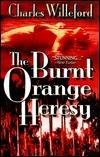The Burnt Orange Heresy, or a Lesson in How to Bluff
 When it comes to bluffing, pros often describe the need to “sell a story” about a hand. For the bluff to be successful, your opponent has to interpret your bet as not violating the logic of previous action (of that particular hand or even of how you’ve played earlier hands). If the bet doesn’t fit with what has gone before, the bluff is that less likely to work. For example, say you’re in a limit game and it folds around to the cutoff who raises. The button and SB both fold to you in the big blind where you’ve been dealt
When it comes to bluffing, pros often describe the need to “sell a story” about a hand. For the bluff to be successful, your opponent has to interpret your bet as not violating the logic of previous action (of that particular hand or even of how you’ve played earlier hands). If the bet doesn’t fit with what has gone before, the bluff is that less likely to work. For example, say you’re in a limit game and it folds around to the cutoff who raises. The button and SB both fold to you in the big blind where you’ve been dealt 
 . You call and the flop comes
. You call and the flop comes 

 . You bet your nut flush draw, your opponent raises, and you call. The turn is the
. You bet your nut flush draw, your opponent raises, and you call. The turn is the  . You check and he checks. The river is the
. You check and he checks. The river is the  . You check and he bets.
. You check and he bets. Now you’re reasonably certain the deuce didn’t help him. He represented an ace on the flop, but then checked behind on the turn, thereby allowing you a free card that might complete all sorts of draws. With any sort of hand at all, he should have bet. Even if he had the absolute nuts on the turn -- i.e., J8 (an unlikely hand with which to preraise) -- he’s still mistaken to allow you a free look at the river. All of which is to say the river bet looks mighty sketchy and probably deserves to be called here. Of course, he could still have a number of hands that beat you (e.g., KK, QQ, JJ, AT, 99, etc.). Even so -- his “story” doesn’t add up, so if he is bluffing, you’re not buying it.
One encounters a lot of bluffing in hard-boiled fiction. For example, Charles Willeford’s The Burnt Orange Heresy, a 1971 novel about an art critic interested in furthering his career by any means necessary, is a book that in many ways is all about bluffing. Willeford wrote two dozen or so novels from the 50s to the 80s, the best probably being Cockfighter (1962) which was made into a curious, largely unseen film in the early 70s. (Two other novels, Miami Blues and The Woman Chaser, were adapted for the screen in the 1990s.) Like other hard-boiled authors, Willeford’s fiction often explores those existential questions that haunt all of us now and again. One frequently finds in Willeford’s novels characters who are convinced that life is without any real meaning, but who nevertheless find reasons to behave in certain ways and do certain things -- and, most importantly, to believe in those actions in such a way as to motivate them to act (and even realize a kind of compromised pleasure or happiness from performing such actions).
In The Burnt Orange Heresy, the critic -- James Figueras -- gets a once-in-a-lifetime opportunity to interview a reclusive French “Nihilist surrealist” named Jacques Debierue. A collector tells Figueras where he can find Debierue, asking only one thing in return for the information -- that Figueras steal one of Debierue’s paintings for him. In fact, thanks to a variety of circumstances (e.g., a fire that destroyed much of his work), not a single one of Debierue’s paintings is known to exist; his reputation as an artist is entirely due to earlier critics’ interpretations of his work over the years. Figueras agrees to steal the painting, knowing that if he can interview Debierue and see some of his work, he could then write an article that would firmly establish his own international reputation as an art critic.
What follows is a gripping, dense plot that includes several twists readers won’t necessarily anticipate. In order to execute his plan, Figueras ends up having to bluff several people -- his girlfriend, the art collector, Debierue, among others. In the end, the novel puts forth the idea that all art is in a way a kind of bluff. As is art criticism. And everything else, really.
Figueras fits right in with other highly skeptical -- even existential -- first-person narrators of hard-boiled fiction like James M. Cain’s Frank Chambers (from The Postman Always Rings Twice) or Jim Thompson’s Lou Ford (from The Killer Inside Me). Because these characters tell their own stories, their authors are particularly challenged to try to justify to the reader both their (often reprehensible) actions and their decision to talk about those actions. Willeford does a great job here with The Burnt Orange Heresy. We buy what Figueras is selling us. As do the other characters. (Even if it turns out they shouldn’t have.)
Image: Charles Willeford, The Burnt Orange Heresy (1971), Amazon.
Labels: *by the book, bluffing, Charles Willeford, The Burnt Orange Heresy














1 Comments:
Good review.The conclusion,while surprising,left me unsatisfied. Mr. Willeford wasn't a fan of art critics apparently.
Post a Comment
<< Home